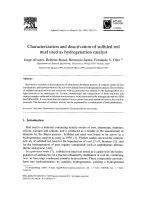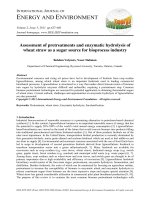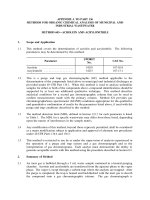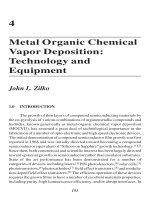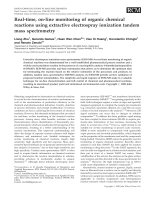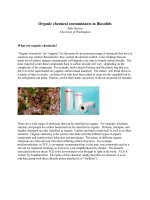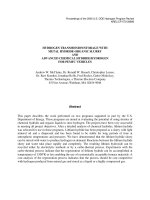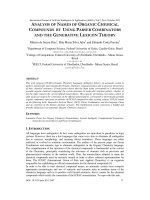BROMINATED AND CHLORINATED ORGANIC CHEMICAL COMPOUNDS USED AS FLAME RETARDANTS ppt
Bạn đang xem bản rút gọn của tài liệu. Xem và tải ngay bản đầy đủ của tài liệu tại đây (205.93 KB, 32 trang )
BROMINATED AND CHLORINATED ORGANIC CHEMICAL
COMPOUNDS USED AS FLAME RETARDANTS
Materials for the December 4-5, 2008 Meeting of the California Environmental Contaminant
Biomonitoring Program (CECBP) Scientific Guidance Panel (SGP)
Agenda Item: “Consideration of Potential Designated Chemicals”
Introduction:
Many brominated and chlorinated compounds have been shown to persist in the environment and
have been associated with adverse health effects including cancer, reproductive and
developmental toxicity and endocrine disruption. A number of brominated and chlorinated
organic chemical compounds are used as flame retardants (BFRs and CFRs). The underlying
structures of BFRs and CFRs vary widely and include: straight-chain paraffins, cycloaliphatic
hydrocarbons, aromatic hydrocarbons and organophosphate compounds.
Flame retardants can be either reactive or additive. Additive flame retardants are incorporated
into a product but are not chemically bound, so that over time they migrate out of the product
and into the environment (e.g., house dust, sewage sludge, food chain). In contrast, reactive
flame retardants are chemically bound to material in the product. The bound chemicals are not
released from products, but residual, unreacted flame retardant present in the product can be
released and lead to human exposure.
In California, all upholstered furniture manufactured or sold in the State has to meet
flammability standards specified in Technical Bulletin No. 117, promulgated by the Bureau of
Home Furnishings and Thermal Insulation. California is the only state that has such a
requirement. This regulation has resulted in extensive use of additive chemical flame retardants,
particularly BFRs and CFRs, in furniture sold in California for over 25 years. To avoid the
expense of having a separate product line for California and to voluntarily comply with the most
stringent flammability requirements in the U.S., many large manufacturers and distributors of
furniture or furniture components have had flame retardants added to their products sold in other
states as well.
Prior to 2006, polybrominated diphenyl ethers (PBDEs) were the primary additive flame
retardants in furniture foam. These additive BFRs migrated from furniture into indoor and
outdoor environments. Some of the highest PBDE concentrations in the world have been found
in California homes and residents. Effective 2006, California became the first state in the nation
to ban two PBDE mixtures, pentaBDEs and octaBDEs, because of concerns about the buildup of
PBDEs in the bodies of Californians and their possible health effects. Commercial decaBDE
which contains approximately three percent of nonaBDE, is banned in the European Union (EU)
and in Washington and Maine.
Many of the BFRs and CFRs included in this document are marketed as substitutes for the
banned PBDEs. Some of these substitute chemicals have already been found in house dust,
indicating that they are being released from products. These chemicals persist in the
Brominated and Chlorinated
Flame Retardants
CECBP 2 December 4-5, 2008
SGP Meeting
environment and many have been found to be bioaccumulative. In addition to the PBDE
replacements, other BFRs and CFRs that are used as flame retardants in a wide of variety of
products.
This document provides a brief overview of the following BFRs and CFRs (listed in alphabetical
order):
Bis(2-ethylhexyl) tetrabromophthalate
Bis(hexachlorocyclopentadieno)cyclooctane
1,2-Bis(2,4,6-tribromophenoxy)ethane
Decabromodiphenylethane
1,2-Dibromo-4-(1,2-dibromoethyl)cyclohexane
2-Ethylhexyl-2,3,4,5-tetrabromobenzoate
Hexabromocyclododecane
Hexachlorocyclopentadienyl-dibromocyclooctane
Pentabromoethylbenzene
Short-chain chlorinated paraffins
Tetrabromobisphenol A
Tris(1,3-dichloro-2-propyl)phosphate
Tris(2-chloroethyl)phosphate
A list of some other BFRs and CFRs is given at the end of the document.
Need to assess efficacy of public health actions:
The State of California banned two commercial mixtures of PBDEs, effective in 2006, because
of concerns about high exposures in California and the potential human health effects of such
exposures. Biomonitoring flame retardants will help the State to assess whether the new
“alternatives” or other flame retardants are also accumulating in California residents and
presenting a threat to public health.
Brominated and Chlorinated
Flame Retardants
CECBP 3 December 4-5, 2008
SGP Meeting
Bis(2-ethylhexyl) tetrabromophthalate (TBPH) [CAS No. 26040-51-7]
Exposure or potential exposure to the public or specific subgroups:
TBPH is an additive flame retardant and one of two brominated chemicals in Firemaster 550, the
primary replacement for pentaBDEs in polyurethane foam. In addition to its uses as a flame
retardant, TBPH is also marketed as a plasticizer for flexible polyvinylchloride and for use in
wire and cable insulation, film and sheeting, carpet backing, coated fabrics, wall coverings and
adhesives. Annual U.S. production/imports were 1-10 million pounds for the reporting years
1990, 1994, 1998 and 2002 (U.S. EPA, 2002). TBPH has recently been identified in house dust
at levels ranging from 1.5 – 10,630 nanograms/gram (ng/g), with a median value of 142 ng/g
(Stapleton et al., 2008). It was recently detected in sewage sludge from wastewater treatment
plants that discharge effluent into the San Francisco Bay (Betts, 2008).
Known or suspected health effects:
TBPH has not been adequately studied for potential human health effects. Health effects are
suspected because TBPH is a brominated analogue of di(ethylhexyl)phthalate (DEHP), which is
listed under Proposition 65 as known to cause cancer and reproductive and developmental
toxicity.
Potential to biomonitor:
Physical and chemical properties
1
:
Vapor pressure: 1.71 x 10
-11
mg Hg at 25ºC
Water solubility:
1.98 x 10
-11
mg/L (estimated, from LogK
ow
)
Octanol/water partition coefficient: LogK
ow
= 11.95 (estimated)
Bioaccumulation: Bioconcentration factor (BCF) 3.2 (predicted, PBT Profiler).
Persistence: Not readily biodegradable, based on 28-day closed bottle test;
Half-life in soil 120 d; in sediment 540 d (predicted, PBT Profiler)
Past biomonitoring studies: None identified.
Availability of analytical methods:
GC-MS methods are being developed. A labeled standard
is available from Wellington Isotope Laboratories. New methods would be required to analyze
metabolites.
1
Data for this section have been taken from various sources. See references for individual flame retardants.
Brominated and Chlorinated
Flame Retardants
CECBP 4 December 4-5, 2008
SGP Meeting
Availability of adequate biospecimens: Serum or breast milk. Urine may be suitable for
metabolite analysis.
Incremental analytical cost: Analysis for the parent compound may be bundled with PBDEs or
other BFRs.
References:
Betts K (2008). New flame retardants detected in indoor and outdoor environments. Environ Sci Technol
42(18):677808.
High Production Volume (HPV) Challenge Program (2004). Test Plan for Phthalic acid Tetrabromo Bis-
2(ethylhexyl) ester. Prepared by Health & Environment Horizons, Ltd. For Brominated Phthalate Ester Panel. July
1, 2004. Available at: />
Muir D and Howard P (2007). Developing analytical methodology for PB&T substances – a systematic process for
identification of important chemicals. Report to U.S. EPA Great Lakes National Program Office, Chicago IL.
September 11, 2007. Environment Canada. Unpublished Report.
PBT Profiler. Developed by Environmental Science Center for the Office of Pollution Prevention and Toxics, U.S.
Environmental Protection Agency. Available at: />
Stapleton et al. (2008). Alternate and new brominated flame retardants detected in U.S. house dust. Environ Sci
Technol
42(18):6910-6.
U.S. Environmental Protection Agency (U.S. EPA, 2002). Non-Confidential Inventory Update Reporting
Production Volume Information. Toxic Substances Control Act (TSCA) Inventory. Available at:
/>
Brominated and Chlorinated
Flame Retardants
CECBP 5 December 4-5, 2008
SGP Meeting
Bis(hexachlorocyclopentadieno)cyclooctane [CAS No. 13560-89-9]
Dechlorane Plus (DP)
Exposure or potential exposure to the public or specific subgroups:
Dechlorane Plus (DP) is an additive chlorinated flame retardant. DP was introduced in the 1960s
as a substitute for Dechlorane (Mirex) which was banned because of toxicity to marine
invertebrates. Uses include electrical wires and cables, connectors for computers and plastic
roofing material. The sole U.S. producer of DP is located in Niagara Falls, New York. DP has
been detected in at least three of the Great Lakes. Studies of DP in sediment cores suggest that
there was a relatively large input of the chemical into the Great Lakes, starting around 1970 and
peaking 5-10 years later. Concentrations in the surface sediment suggest that the input of DP is
now about half of what it was at its peak. U.S. production/import volume was reported as 1-10
million pounds for 1986 and each year since then (U.S. EPA, 2002). The extent to which DP
may be used as a substitute for banned or phased out PBDEs is unknown. DP has recently been
found in air, fish and sediment samples in the Great Lakes Region (Hoh et al., 2006) and in
Herring Gull eggs (Gauthier et al., 2007). DP has also been detected in tree bark in the
northeastern United States, with higher levels near the U.S. manufacturing source in Niagara
Falls, New York. DP has also been detected at relatively high concentrations in bark samples
from Korea and China, suggesting manufacturing in Asia (Qiu et al., 2008). DP has been found
in house dust in Ottawa, Canada (Zhu et al., 2007).
Known or suspected health effects:
Although DP has been in use for over 40 years, toxicological data could not be located. DP
shares a structural feature, the chlorinated norbornene moiety, with a number of chemicals listed
under Proposition 65. The chemicals (and their Proposition 65 designation) are as follows: the
flame retardant chlorendic acid (cancer) and organochlorine pesticides dieldrin (cancer),
chlordane (cancer), heptachlor (cancer and developmental toxicity), and endrin (developmental
toxicity). The organochlorine pesticide endosulfan also has this structural feature. DP has a
larger molecular size than the above chemicals which may hinder its bioavailability.
Potential to biomonitor:
Physical and chemical properties
Vapor pressure: 7.1 x 10
-10
mm Hg at 25ºC (predicted)
Water solubility: 4.4 x 10-8 mg/L
Octanol/water partition coefficient: Log K
ow
11.6 (predicted)
Brominated and Chlorinated
Flame Retardants
CECBP 6 December 4-5, 2008
SGP Meeting
Bioaccumulation: BCF 3.2 (predicted, PBT Profiler)
Persistence: Half-life in soil 360 d; in sediment 1600 d (predicted, PBT Profiler)
Stereoisomers: Syn- and anti-isomers of DP appear to bioaccumulate differently.
Past biomonitoring studies: None identified.
Availability of analytical methods: GC-MS methods are available. Unlabelled standards are
available from Cambridge Isotope Laboratories.
Availability of adequate biospecimens: Serum or breast milk.
Incremental analytical cost: Analysis can be bundled with current PBDE or POP methods.
Costs for separation of stereoisomers will be greater.
References:
Betts K (2008). New data on widely used flame retardant. Environ Sci Technol 42:5-6.
Gauthier et al. (2007). Current-use flame retardants in the eggs of herring gulls (Laurus argentatus) from the
Laurentian Great Lakes. Environ Sci Technol 41:4561-4567.
Hoh et al. (2006). Dechlorane Plus, a chlorinated flame retardant, in the Great Lakes. Environ Sci Technol
40:1184-1189.
HSDB (Hazardous Substances Data Bank). Available at />
Qiu et al. (2008). Dechlorane Plus: a review with new data. Organohalogen Compounds 70:216-219.
U.S. Environmental Protection Agency (U.S. EPA, 2002). Non-Confidential Inventory Update Reporting
Production Volume Information. Toxic Substances Control Act (TSCA) Inventory. Available at:
/>
Zhu et al. (2007). Detection of dechlorane plus in residential indoor dust in the city of Ottawa, Canada. Environ Sci
Technol 41:7694-8.
Zhu et al. (2008). Identification and determination of hexachlorocyclopentadienyl-dibromocyclooctane (HCDBCO)
in residential indoor air and dust: a previously unreported halogenated flame retardant in the environment. Environ
Sci Technol 42:386-91.
Brominated and Chlorinated
Flame Retardants
CECBP 7 December 4-5, 2008
SGP Meeting
1,2-Bis(2,4,6-tribromophenoxy)ethane (BTBPE) [CAS No. 37853-59-1]
Exposure or potential exposure to the public or specific subgroups:
BTBPE is an additive flame retardant in thermoplastic and thermosetting plastics systems and
may be used as a replacement for octaBDE mixtures. Annual U.S. production/imports were 10-
50 million pounds for the reporting years 1986, 1990 and 1994, but decreased to 1-10 million
pounds in 1998 and 2002 (U.S. EPA, 2002). Information on current use and production volume,
which might indicate increasing use as a PBDE replacement, is unavailable. Recent studies
report detection of BTBPE in ambient air samples collected from several sites around the U.S.
and also in sediment samples from Lake Michigan (Hoh et al., 2005). BTBPE has been detected
in Northern Fulmar eggs from the Faroe Islands (Karlsson et al., 2006), in Herring Gull eggs in
the Great Lakes basin (Gauthier et al., 2007), in Glaucous Gull eggs from the Norwegian Arctic
(Verreault et al., 2007) and in the Lake Winnipeg (Canada) food web. BTBPE has been recently
found in house dust from the United States, with levels ranging from 1.6 to 789 ng/g (Stapleton
et al., 2008).
Known or suspected health effects:
BTBPE is structurally similar to DBDPE and decaBDE (see discussion of toxicity for DBDPE).
One identified metabolite of BTBPE is the flame retardant 2,4,6-tribromophenol. Research
findings indicate that 2,4,6-tribromophenol is a thyroid hormone disrupting chemical (Hamers et
al., 2006; Suzuki et al., 2008). A Japanese study found 2,4,6-tribromphenol in umbilical cord
and umbilical cord blood samples (Kawashiro et al., 2008).
Potential to biomonitor:
Physical and chemical properties:
Vapor pressure: 2.3 x 10
-1
mm Hg (estimated)
Water solubility: 0.2 mg/L
Octanol/water partition coefficient: LogK
ow
9.15 (estimated)
Bioaccumulation: BCF 8.7-27.1 (measured in Cyprinus carpio in the Great Lakes)
Persistence: Half-life in soil 360 d; in sediment, 1600 d (predicted, PBT Profiler)
Pharmacokinetics and metabolism: Dietary studies in animals suggest minimal gastrointestinal
absorption. One study found that after dietary administration, the great majority of BTBPE was
excreted unchanged in the feces. However, metabolites have been identified and characterized
(Hakk et al., 2004). Metabolites include 2,4,6-tribromophenol and hydroxylated-BTBPE
products, suggesting cytochrome P-450 mediated biotransformation. Although inhalation may
be the predominant route of human exposure, no studies of inhalation exposure were found.
Past biomonitoring studies: None identified.
Brominated and Chlorinated
Flame Retardants
CECBP 8 December 4-5, 2008
SGP Meeting
Availability of analytical methods: GC-MS methods for environmental analysis exist. Isotope
labeled standards are available from Cambridge Isotope Laboratories (
13
C
12
).
Availability of adequate biospecimens:
Breast milk and serum samples for parent compound;
serum or urine for metabolites.
Incremental analytical cost: Analysis of the parent compound may be bundled with other BFRs
using current PBDE or POPs methods; costs for metabolite analysis may be greater.
References:
Gauthier et al. (2007). Current-use flame retardants in the eggs of herring gulls (Laurus argentatus) from the
Laurentian Great Lakes. Environ Sci Technol 41:4561-4567.
Hakk et al. (2004). Metabolism, tissue disposition and excretion of 1,2-bis(2,4,6-tribromophenoxy)ethane (BTBPE)
in male Sprague-Dawley rats. Chemosphere 54: 1367-1374
.
Hakk H and Letcher RJ (2003). Metabolism in the toxicokinetics and fate of brominated flame retardants – a
review. Environ Intl 29:801-828.
Hamers et al. (2006). In vitro profiling of the endocrine-disrupting potency of brominated flame retardants Toxicol
Sci 92:157-173.
Hoh E et al. (2005). Novel flame retardants, 1,2-bis(2,4,6-tribromophenoxy)-ethane and 2,3,4,5,6-
pentabromoethylbenzene, in the United States’ Environmental Samples. Environ Sci Technol 39:2472-2477.
Kawashiro et al. (2008). Perinatal exposure to brominated flame retardants and polychlorinated biphenyls in Japan.
Endocr J August 22, 2008. [Epub ahead of print].
Karlsson et al. (2006). Levels of brominated flame retardants in Northern Fulmar (Fulmaris glacialis) eggs from the
Faroe Islands. Sci Total Environ 367:840-846.
Lyubimov et al. (1998). Developmental neurotoxicity and immunotoxicity in Wistar rats. Neurotoxicology 19:303-
12.
Law et al. (2006). Bioaccumulation and trophic transfer of some brominated flame retardants in a Lake Winnipeg
(Canada) food web. Environ Toxicol Chem 25:2177-2186.
Muir D and Howard P (2007). Developing analytical methodology for PB&T substances – a systematic process for
identification of important chemicals. Report to U.S. EPA Great Lakes National Program Office, Chicago IL.
September 11, 2007. Environment Canada. Unpublished Report.
PBT Profiler. Developed by Environmental Science Center for the Office of Pollution Prevention and Toxics, U.S.
Environmental Protection Agency. Available at: />
Stapleton et al. (2008). Alternate and new brominated flame retardants detected in U.S. house dust, Environ Sci
Technol
42(18):6910-6.
Suzuki et al. (2008). Identification of brominated and chlorinated phenols as potential thyroid-disrupting
compounds in indoor dusts. Environ Sci Technol 42:1974-1800.
Brominated and Chlorinated
Flame Retardants
CECBP 9 December 4-5, 2008
SGP Meeting
Syracuse Research Corporation (SRC). PhysProp Database. Available at:
Tomy et al. (2007). Dietary exposure of juvenile rainbow trout (Oncorhynchus mykiss) to 1,2-bis(2,4,6-
tribromophenoxy)ethane: Bioaccumulation parameters, biochemical effects and metabolism. Environ Sci Technol
41:4913-4918.
U.S. Environmental Protection Agency (U.S. EPA, 2002). Non-Confidential Inventory Update Reporting
Production Volume Information. Toxic Substances Control Act (TSCA) Inventory. Available at:
/>
Verreault et al. (2007). Brominated flame retardants in glaucous gulls from the Norwegian Arctic: More than just
an issue of polybrominated diphenyl ethers. Environ Sci Technol 41:4925-2931.
Brominated and Chlorinated
Flame Retardants
CECBP 10 December 4-5, 2008
SGP Meeting
Decabromodiphenylethane (DBDPE) [CAS No. 84852-53-9]
Exposure or potential exposure to the public or specific subgroups:
DBDPE is an additive flame retardant that has similar applications to those of decaBDE (e.g., in
both acrylonitrile-butadiene-styrene (ABS) and high impact polystyrene (HIPS) plastics as well
as textile backcoating) and has been marketed as general purpose substitute for decaBDE.
Information on trends in use and production volume, which might suggest the use of DBDPE as
a PBDE replacement, is unavailable. DBDPE was recently detected in fish in Lake Winnipeg,
Canada (Law et al., 2006) and found in house dust from the United States, with levels ranging
from <10 ng/g to 11,070 ng/g (Stapleton et al., 2008).
Known or suspected health effects:
DBDPE is structurally similar to decaBDE, the PBDE mixture still in commercial use in
California. Research findings indicate that, like exposures to the other PBDE mixtures,
decaBDE exposures to neonatal animals cause changes in learning and behavior in adult animals
(Viberg et al., 2003). Viberg et al. (2007) found that neonatal exposure to decaBDE resulted in
an altered response to nicotine, indicating a change in the brain cholinergic system.
Potential to biomonitor:
Physical and chemical properties:
Vapor pressure: ~1 x 10
-6
Pa at 25 °C (assumed, Dungey and Akintoye, 2007)
Water solubility: ~ 0.72 μg/L at 25 °C (measured, Dungey and Akintoye, 2007)
Octanol/water partition coefficient: LogK
ow
= 3.55 ( measured, but considered an estimate due
to analytical uncertainties); other estimates: 7-10 (Dungey and Akintoye, 2007).
Bioaccumulation: BCF 3.2 (predicted, PBT Profiler).
Persistence: Half-life in soil 360 d; 1600 d in sediment (predicted, PBT Profiler)
Past biomonitoring studies: None identified
Availability of analytical methods:
GC-MS methods exist for environmental analysis of
DBDPE; a standard is available from Wellington Isotope Laboratories. Analytical challenges
similar to those with decaBDE exist, due to the number of bromine atoms in the molecule.
Brominated and Chlorinated
Flame Retardants
CECBP 11 December 4-5, 2008
SGP Meeting
Availability of adequate biospecimens: Plasma or serum. Human levels of DBDPE will likely
be low due to its high molecular weight (similar to decaBDE). Required sample volume may be
2-5 mL.
Incremental analytical cost: Analysis can be bundled with PBDEs or other BFRs.
References:
Dungey S and Akintoye L. (2007). Environmental risk evaluation report: 1,1'-(Ethane-1,2-diyl)bis[penta-
bromobenzene] CAS: 84852-53-9. Product Code: SCHO0507BMOR-E-P. Environment Agency for England and
Wales. Available at: www.environment-agency.gov.uk
Law et al. (2006) Bioaccumulation and trophic transfer of some brominated flame retardants in a Lake Winnipeg
(Canada) food web Environ Toxicol Chem 25:2177-2186.
Pakalan et al. (2007). Review on production processes of decabromodiphenyl ether (decaBDE) used in polymeric
applications in electrical and electronic equipment, and assessment of the availability of potential alternatives to
decaBDE. European Chemicals Bureau. European Commission. January 2007. Available at:
/>
PBT Profiler. Developed by Environmental Science Center for the Office of Pollution Prevention and Toxics, U.S.
Environmental Protection Agency. Available at: />
Stapleton et al. (2008). Alternate and new brominated flame retardants detected in U.S. house dust, Environ Sci
Technol
42(18):6910-6.
Viberg et al. (2007). Changes in spontaneous behaviour and altered response to nicotine in the adult rat, after
neonatal exposure to the brominated flame retardant, decabrominated diphenyl ether (PBDE 209).
Neurotoxicolog
. 28:136-42.
Viberg et al. (2003). Neurobehavioral derangements in adult mice receiving decabrominated diphenyl ether (PBDE
209) during a defined period of neonatal brain development. Toxicol Sci 76:112-120.
Brominated and Chlorinated
Flame Retardants
CECBP 12 December 4-5, 2008
SGP Meeting
1,2-Dibromo-4-(1,2-dibromoethyl)cyclohexane [CAS No. 3322-93-8]
Tetrabromoethylcyclohexane [TBECH]
Br
B
r
CH CH
2
Br
B
r
Exposure or potential exposure to the public or specific subgroups:
TBECH is an additive flame retardant used primarily in expandable polystyrene beads (used for
thermal insulation in housing). It is also used as a flame retardant for extruded polystyrene foam
and for adhesives in fabric and vinyl lamination, electrical cable coatings, high-impact plastic
parts of appliances and some construction materials (U.S. EPA, 1984). Annual U.S.
production/imports were 10,000-500,000 pounds for the reporting years 1986, 1990, 1994, 1998
and 2002 (U.S. EPA, 2002). TBECH was recently identified in blubber of Beluga whales from
the Canadian Arctic (Tomy et al., 2008).
Known or suspected health effects:
Findings from a recent in vitro study suggest that TBECH is a strong androgen agonist (Larsson
et al., 2006). TBECH was shown to bind to and activate the human androgen receptor in human
liver cells. Further, co-exposure to the androgen dihydrotestosterone and TBECH resulted in
additive androgen activity. TBECH was found to be mutagenic in an in vitro study in
mammalian cells (McGregor et al., 1991).
Potential to biomonitor:
Physical and chemical properties:
Vapor pressure: 1.05 x 10
-4
mm Hg (estimated, SRC, 2000)
Water solubility: 0.0692 mg/L (estimated, SRC, 2000)
Octanol/water partition coefficient: Log K
ow
= 5.24 (estimated, SRC, 2000)
Bioaccumulation: BCF 2000 (predicted, FR, 1984)
Persistence: Half life in soil: 75 days (predicted PBT profiler).
Stereoisomers: The technical mixture of TBECH consists primarily of a 1:1 mixture of α-
TBECH and β-TBECH, two of four diastereomers. The other two diastereomers, γ-TBECH and
δ-TBECH, can be formed by interconversion at high temperatures. Although not present in the
technical mixture, they may be relevant environmental contaminants because of the high
temperatures used in manufacturing processes.
Past biomonitoring studies: None identified.
Availability of analytical methods: GC-MS methods have been developed.
Brominated and Chlorinated
Flame Retardants
CECBP 13 December 4-5, 2008
SGP Meeting
Availability of adequate biospecimens: Serum or breast milk.
Incremental analytical cost: Analysis can be bundled with PBDEs or other BFRs.
References:
Arsenault et al. (2008). Structure characterization and thermal stabilities of the isomers of the brominated flame
retardant 1,2-dibromo-4-(1,2-dibromoethyl)cyclohexane. Chemosphere 72:1163-117-
Larsson et al. (2006). Identification of the brominated flame retardant 1,2-dibromo-4-(1,2-
dibromoethyl)cyclohexane as an androgen agonist. J Med Chem 49:7366-7372.
McGregor et al. (1991). Responses to the L5178Y Mouse Lymphoma Forward Mutation Assay. V: 27 coded
Chemicals. Environ Mol Mutagen 17:196-219.
PBT Profiler. Developed by Environmental Science Center for the Office of Pollution Prevention and Toxics, U.S.
Environmental Protection Agency. Available at: />
Syracuse Research Corporation (SRC). PhysProp Database. Available at:
/>.
Tomy et al. (2008) Identification of the novel cycloaliphatic brominated flame retardant 1,2-dibromo-4-(1,2-
dibromoethyl)cyclohexane in Canadian Arctic Beluga (Delphinapterus leucas). Environ Sci Technol 42:543-549.
U.S. EPA (1984). Fourteenth Report of the Interagency Testing Committee to the Administrator; receipt of report
and request for comments regarding priority list of chemicals. Federal Register 49:22389-22401. May 29, 1984.
U.S. Environmental Protection Agency (U.S. EPA, 2002). Non-Confidential Inventory Update Reporting
Production Volume Information. Toxic Substances Control Act (TSCA) Inventory. Available at:
/>
Brominated and Chlorinated
Flame Retardants
CECBP 14 December 4-5, 2008
SGP Meeting
2-Ethylhexyl-2,3,4,5-tetrabromobenzoate (TBB) [CAS No. 183658-27-7]
Exposure or potential exposure to the public or specific subgroups:
TBB is an additive flame retardant. It is the major brominated component in the flame retardant
mixture Firemaster 550 (FM550), the primary replacement for pentaBDEs in polyurethane foam.
The other brominated chemical in Firemaster 550 is bis(2-ethylhexyl) tetrabromophthalate
(TBPH). The approximate ratio of TBB/TBPH in FM550 is 4:1. TBB has recently been
identified in house dust at levels ranging from <6/6 – 15,030 ng/g (Stapleton et al., 2008). TBB
was recently detected in sewage sludge from wastewater treatment plants that discharge effluent
into the San Francisco Bay (Betts, 2008).
Known or suspected health effects:
Toxicological data on TBB could not be located. However, TBB is structurally similar to TBPH,
lacking only the second ester group. Health effects are suspected for TBPH, a brominated
analogue of di(ethylhexyl)phthalate (DEHP) which is listed under Proposition 65 as known to
cause cancer and reproductive and developmental toxicity.
Potential to biomonitor:
Physical and chemical properties:
Vapor pressure: Not identified.
Water solubility: 1.144 x 10
-5
mg/L at 25
o
C (predicted, U.S. EPA, 2008)
Octanol/water partition coefficient: LogK
ow
= 8.75 (predicted, U.S. EPA, 2008)
Bioaccumulation: BCF 260 (predicted, PBT Profiler)
Persistence: Half-life in soil 120 d; in sediment 540 d (predicted, PBT Profiler)
Past biomonitoring studies: None identified.
Availability of analytical methods:
GC-MS methods have been developed. New methods will
be required to analyze metabolites.
Biospecimen availability: Serum or breast milk. Urine may be suitable for metabolite analysis.
Incremental analytical cost:
Analysis of the parent compound can be bundled with PBDEs or
other BFRs.
Brominated and Chlorinated
Flame Retardants
CECBP 15 December 4-5, 2008
SGP Meeting
References:
Betts K (2008). New flame retardants detected in indoor and outdoor environments. Environ Sci Technol
42(18):6778.
Stapleton et al. (2008). Alternate and new brominated flame retardants detected in U.S. house dust. Environ Sci
Technol
42(18):6910-6.
PBT Profiler. Developed by Environmental Science Center for the Office of Pollution Prevention and Toxics, U.S.
Environmental Protection Agency. Available at: />
US EPA (2008). Estimation Programs Interface Suite
™
for Microsoft® Windows, v 3.20. United States
Environmental Protection Agency, Washington, DC, USA. Available at:
/>
Brominated and Chlorinated
Flame Retardants
CECBP 16 December 4-5, 2008
SGP Meeting
Hexabromocyclododecane (HBCD)
α-HBCD CAS No. 34237-50-6
β-HBCD CAS No. 34237-51-7
γ-HBCD CAS No.134237-52-8
Mixed isomers (α-, β-, γ-) CAS No. 3194-55-6
Stereochemistry unspecified CAS No. 25637-99-4
Exposure or potential exposure to the public or specific subgroups:
HBCD is an additive flame retardant used in polystyrene insulation boards, in building
constructions (e.g., house walls, indoor ceilings); in HIPS plastic for electrical and electronic
parts (e.g., housings for VCRs, video cassette housings); as a textile coating agent (e.g.,
upholstery fabric, bed mattress ticking, upholstery seating in transportation, draperies and wall
coverings). Annual U.S. production/import volume was 10-50 million pounds for the reporting
years 1994, 1998 and 2002 (U.S. EPA, 2002). Although use in North America has been
historically much less than that in Europe, HBCD may be used increasingly as a substitute for
PBDEs. Long-range atmospheric transport and biomagnification in top predators, including
marine mammals and birds of prey have been documented. Analysis of HBCD in tissues of
harbor porpoises from the United Kingdom from 1994-2003 indicated a sharp increase in HBCD
concentrations from about 2001 onward (Law et al., 2006). In California, levels of HBCD in sea
lions increased from 0.7 to 12 ng/g wet weight between 1993 and 2003 (Stapleton et al., 2006).
HBCD has been recently found in house dust from the United States, Canada and the United
Kingdom (Abdallah et al., 2008). In a recent study in the U.S., HBCD levels in house dust
ranged from <4.5 ng/g and 130,200 ng/g (Stapleton et al., 2008).
γ-HBCD is the predominant stereoisomer in commercial HBCD mixtures (75-89%); however,
rearrangement of the configuration of HBCDs can occur at the high temperatures required to
incorporate HBCD into products such as extruded polystyrene. α-HBCD has been found to be
the predominant stereoisomer in marine fish, birds, mammals and humans in most studies.
Levels of α-HBCD in indoor dust average 32% of total HBCDs (range, 14-67%).
Known or suspected health effects:
Developmental and reproductive toxicity studies have found decreased fertility (Ema et al.,
2008) and after neonatal exposure to HBCD, significant changes in spontaneous behavior,
learning and memory (Eriksson et al., 2006). Other effects include interference with thyroid
Brominated and Chlorinated
Flame Retardants
CECBP 17 December 4-5, 2008
SGP Meeting
hormone homeostasis, cytochrome P450 induction (van der Ven et al., 2006) and inhibition of
neurotransmitter uptake (Mariussen and Fonnum, 2003).
Potential to biomonitor:
Physical and chemical properties:
Vapor pressure: 4.7x10
-7
mm Hg at 21ºC
Water solubility (μg/L): α-HBCD 48.8±1.9, β-HBCD 14.7±0.5, γ-HBCD 2.1±0.2.
Octanol/water partition coefficient: LogK
ow
= 5.625 technical mixture; individual stereoisomers:
α-HBCD 5.07 ± 0.09, β-HBCD 5.12 ± 0.09, γ-HBCD 5.47 ± 0.10
Bioaccumulation: BCF > 6000
Persistence: Half-life in aerobic soil is > 120 d.
Past biomonitoring studies:
Antignac et al. (2008) studied 26 mother-infant pairs in France and found α-HBCD in 50% of
samples of maternal adipose tissue (levels ranging from 1 – 12 ng/g lw). α-HBCD was found in
7 of 26 breast milk samples (levels ranging from 2.5 – 5 ng/g lw). HBCD was not found in
maternal or infant serum samples, which the authors attributed to both a very restricted sample
amount and the LC-MS/MS equipment used. Weiss et al. (2004) found HBCD in both maternal
and cord blood in the Netherlands. HBCD in maternal blood was measured during weeks 20 and
35 of pregnancy (n=78) and averaged 1.1 ng/g lw with a range of <0.16-7.0 ng/g lw. The mean
in cord blood (n=12) was 1.7 ng/g lw with a range of <0.16-4.2 ng/g lw. Guerra et al. (2008)
found HBCD in 13 of 15 breast milk samples with levels ranging from 7.9 to 188 ng/g lw.
Unlike other studies, this Spanish study found markedly higher levels of γ-HBCD compared to
levels of α-HBCD.
Availability of analytical methods: Reliable methods for the analysis have been established and
are readily available for GC-MS or LC-MS/MS analysis. Isotope labeled standards (
13
C
12
) are
available from Cambridge Isotope Laboratories and Wellington Laboratories.
Availability of adequate biospecimens: HBCD can be detected in serum or breast milk.
Incremental analytical cost:
LC-MS/MS can be used for analysis; however, new method
development will be required. Sample extraction and clean-up can possibly be bundled with
methods for other BFRs. Samples could also be analyzed with current GC-MS based methods
and bundled with other BFRs for analysis.
References:
Abdallah et al. (2008). Hexabromocyclododecanes in indoor dust from Canada, the United Kingdom and the United
States. Environ Sci Technol 42:459-464.
Antignac, JR, Cariou R, Maume D et al (2008). Exposure assessment of fetus and newborn to brominated flame
retardants in France: preliminary data. Mol Nutr Food Res 52:258-265.
Covaci et al. (2006). Hexabromocyclododecanes (HBCDs) in the Environment and Humans: A Review. Environ
Sci Technol 40:3679-3688.
Brominated and Chlorinated
Flame Retardants
CECBP 18 December 4-5, 2008
SGP Meeting
Ema M, Fujii, S, Hirata-Koizumi M, Matsumoto M (2008). Two-generation reproductive toxicity study of the flame
retardant hexabromocyclododecane in rats. Reprod Toxicol 25:335-51.
Eriksson P et al. (2002). A comparison on developmental neurotoxic effects of hexabromocyclododecane,
2,2',4,4',5,5'-hexabromodiphenylether (PBDE153) and 2,2',4,4',5,5',-hexachlorobiphenyl (PCB 153) Organohalogen
Compd 57:389-392.
European Union (2008). Annex XV dossier. Proposal for identification of a substance as a
CMR, CAT 1 or 2, PBT, vPvB or a substance of an equivalent level of concern. Proposal for identification of
hexabromocyclododecane as a SVHC. Identification of SVHC CAS NO: 25637-99-4
Guerra et al. (2008). Hexabromocyclododecane in human breast milk: levels and enantiomeric patterns.
Organohalogen Compounds 70:309-312.
Johnson-Restrepo et al. (2008). Tetrabromobisphenol A (TBBPA) and hexabromocyclododecanes (HBCDs) in
tissues of humans, dolphins, and sharks from the United States. Chemosphere 70:1935-1944.
Law et al. (2006). Levels of the flame retardants hexabromocyclododecane and tetrabromobisphenol A in the
blubber of harbor porpoises (Phocoena phocoena) stranded or caught in the U.K., with evidence for an increase in
HBCD concentrations in recent years. Environ Sci Technol 40:2177-2183.
Mariussen E and Fonnum F (2003). The effect of brominated flame retardants on neurotransmitter uptake into rat
brain synaptosomes and vesicles. Neurochem Int 43:533-42.
PBT Profiler. Developed by Environmental Science Center for the Office of Pollution Prevention and Toxics, U.S.
Environmental Protection Agency. Available at: />
Stapleton et al. (2006). Determination of HBCD, PBDEs and MeO-BDEs in California sea lions (Zalophus
californianus) stranded between 1993 and 2003. Mar Pollut Bull 52:522-31.
Stapleton et al. (2008). Alternate and new brominated flame retardants detected in U.S. house dust. Environ Sci
Technol
42(18):6910-6.
Syracuse Research Corporation (SRC). PhysProp Database. Available at:
/>.
U.S. Environmental Protection Agency (U.S. EPA, 2002). Non-Confidential Inventory Update Reporting
Production Volume Information. Toxic Substances Control Act (TSCA) Inventory. Available at:
/>
Van der Ven et al. (2006). A 28-day oral dose toxicity study enhanced to detect endocrine effects of
hexabromocyclododecane in Wistar rats. Toxicol Sci 94: 281-292.
Weiss J et al. (2004). PBDE and HBCDD levels in blood from Dutch mothers and infants- Analysis of a Dutch
Groningen Infant Cohort. Organohalogen Compd 66: 2677-2682.
Brominated and Chlorinated
Flame Retardants
CECBP 19 December 4-5, 2008
SGP Meeting
Hexachlorocyclopentadienyl-dibromocyclooctane (HCDBCO)
[CAS No. 51936-55-1]
Br
Br
Cl
Cl
Cl
Cl
Cl
Cl
Exposure or potential exposure to the public or specific subgroups: HCDBCO is a flame
retardant that shares a structural feature with Dechlorane Plus (i.e., the chlorinated norbornene
moiety). HCDBCO is unusual among flame retardants in that it contains both chlorine and
bromine atoms. Its use as a flame retardant is reportedly in “styrenic polymers” (IPCS, 1997).
No information was found on the U.S. production/imports volume for this chemical. HCDBCO
has been found in house dust in Ottawa, Canada at levels ranging from less than 0.24 ng/g to
93,000 ng/g, with a median level of 2.0 ng/g (n=69). HCDBCO was also found in indoor air
samples at levels that were higher than those of the major PBDE congeners (Zhu et al., 2008).
Known or suspected health effects:
There is little information on the toxicity of HCDBCO. HCDBCO, like Dechlorane Plus, has a
structural similarity to several chemicals listed under Proposition 65. These chemicals share the
same chlorinated norbornene moiety. The chemicals (and their Proposition 65 designation) are
as follows: the flame retardant chlorendic acid (cancer), the organochlorine pesticides dieldrin
(cancer), chlordane (cancer), heptachlor (cancer and developmental toxicity), and endrin
(developmental toxicity). The organochlorine pesticide endosulfan also has this structural
feature.
Potential to biomonitor:
Physical and chemical properties
Vapor pressure: Not identified.
Water solubility: 6.84 x 10
-5
(predicted, U.S. EPA, 2008)
Octanol/water partition coefficient: Log K
ow
7.91
Bioaccumulation: BCF 3600 (predicted, PBT Profiler)
Persistence: Half-life in soil 360 d; in sediment 1600 d (predicted, PBT Profiler)
Past biomonitoring studies: None identified.
Availability of analytical methods:
GC-MS.
Availability of adequate biospecimens: Serum or plasma.
Brominated and Chlorinated
Flame Retardants
CECBP 20 December 4-5, 2008
SGP Meeting
Incremental analytical cost: New analytic methods may need to be developed. HCDBCO can
possibly be bundled with PBDEs and/or other BFRs using current PBDE and other POP
methods.
References:
IPCS (1997). Flame Retardants: A General Introduction. Environmental Health Criteria 192. International
Program of Chemical Safety. World Health Organization. Available at:
/>.
PBT Profiler. Developed by Environmental Science Center for the Office of Pollution Prevention and Toxics, U.S.
Environmental Protection Agency. Available at: />
U.S. EPA (2008). Estimation Programs Interface Suite
™
for Microsoft® Windows, v 3.20. United States
Environmental Protection Agency, Washington, DC, USA. Available at:
/>
Zhu et al. (2008). Identification and determination of hexachlorocyclopentadienyl-dibromocyclooctane (HCDBCO)
in residential indoor air and dust: a previously unreported halogenated flame retardant in the environment. Environ
Sci Technol 42:386-91.
Brominated and Chlorinated
Flame Retardants
CECBP 21 December 4-5, 2008
SGP Meeting
Pentabromoethylbenzene (PBEB) [CAS No. 85-22-3]
Br
B
r
Br
Br
B
r
Use and extent of exposure:
PBEB is an additive flame retardant that was used in thermoset polyester resins (circuit boards,
textiles, adhesives, wire and cable coatings, polyurethanes) and thermoplastic resins in the
1970’s and 1980’s. Production was reported to have declined after the U.S. Environmental
Protection Agency (EPA) proposed that the manufacturer test for environmental fate and effects
in 1985. U.S. production/import volume was listed as 10,000-500,000 pounds for 1986, but no
information is available beyond that time (U.S. EPA, 2002). U.S. EPA withdrew its proposed
rule for testing in 1988 as at that time it found no intended manufacturing or processing of the
chemical (Hoh et al., 2005). However, relatively high concentrations of PBEB were recently
detected in Chicago air samples (Hoh et al., 2005). PBEB has been detected in pooled samples
of Herring Gull eggs in the Great Lakes basin (Gauthier et al., 2007) and in egg yolk samples of
Glaucous Gulls from the Norwegian Arctic (Verreault et al., 2007).
Known or suspected health effects:
Toxicological data on PBEB could not be located. Health effects are suspected because PBEB is
a brominated analogue of ethylbenzene, which is listed as known to cause cancer under
Proposition 65.
Potential to biomonitor:
Physical and chemical properties:
Vapor pressure: 4.69 x 10
-6
mm Hg (estimated, SRC 2000)
Water solubility: 0.0467 mg/L at 25ºC (estimated, SRC 2000)
Octanol/water partition coefficient: Log K
ow
= 7.48 (estimated, SRC 2000)
Bioaccumulation: BCF 14000 (predicted, PBT Profiler)
Persistence: Half-life in soil 360 d; in sediment 1600 d (predicted, PBT Profiler)
Past biomonitoring studies: None identified.
Availability of analytical methods: GC-MS methods have been developed.
Availability of adequate biospecimens: Serum or breast milk.
Brominated and Chlorinated
Flame Retardants
CECBP 22 December 4-5, 2008
SGP Meeting
Incremental analytical cost: Analysis can be bundled with PBDE or other BFRs.
References:
Gauthier et al. (2007). Current-use flame retardants in the eggs of herring gulls (Laurus argentatus) from the
Laurentian Great Lakes. Environ Sci Technol 41:4561-4567.
Hoh et al. (2005). Novel flame retardants, 1,2-bis(2,4,6-tribromophenoxy)-ethane and 2,3,4,5,6-
pentabromoethylbenzene, in United States’ environmental samples. Environ Sci Technol 39:2472-2477.
PBT Profiler. Developed by Environmental Science Center for the Office of Pollution Prevention and Toxics, U.S.
Environmental Protection Agency. Available at: />
Syracuse Research Corporation (SRC). PhysProp Database. Available at:
/>
U.S. Environmental Protection Agency (U.S. EPA, 2002). Non-Confidential Inventory Update Reporting
Production Volume Information. Toxic Substances Control Act (TSCA) Inventory. Available at:
/>
Verreault et al. (2007). Brominated flame retardants in glaucous gulls from the Norwegian Arctic: More than just
an issue of polybrominated diphenyl ethers. Environ Sci Technol 41:4925-2931.
Brominated and Chlorinated
Flame Retardants
CECBP 23 December 4-5, 2008
SGP Meeting
Short-chain chlorinated paraffins
Chain length C
10
– C
13
[CAS No. 85535-84-8 and 71011-12-6]
Example structure: C
13
H
22
Cl
6
Exposure or potential exposure to the public or specific subgroups:
There are three categories of chlorinated paraffins: Short-chain chlorinated paraffins (SCCPs),
medium-chain chlorinated paraffins (MCCPs) and long-chain chlorinated paraffins (LCCPs).
SCCPs are discussed here because of their known toxicological effects. SCCPs are used
primarily as in metal-working fluids but they are also used as flame retardants (as well as
plasticizers and in paints and sealants). SCCPs have been found in water and sediments in the
Great Lakes and elsewhere worldwide. Houde et al. (2008) found high levels of SCCPs in food
webs from Lake Ontario and Lake Michigan. Chlorinated paraffins have been found in
Canadian Arctic biota (Environment Canada, 2004).
Known or suspected health effects:
Chlorinated paraffins (average chain length, C12; approximately 60 percent chlorine by weight)
(i.e., SCCPs) are listed as causing cancer under Proposition 65.
Potential to biomonitor:
Physical and chemical properties:
Vapor pressure: 0.0213 Pa (Australian Government, 2004)
Water solubility: 150-470 μg/L was reported for C
11
; 59% Cl. (IPCS, 1996)
Octanol/water partition coefficient: Log K
ow
4.39-8.01 (IPCS, 1996)
Bioaccumulation: BCFs 5,785-138,000 wet wt, measured in mussels (Environment Canada,
2004); BCFs 1,000 to 50,000 reported in freshwater and marine organisms (whole body)
(Australian Government, 2004).
Persistence: Residues in Canadian lake sediments, dating back over 25 years, suggest that the
half-life in sediment is greater than 1 year (Environment Canada, 2004).
Past biomonitoring studies: Short-chain chlorinated paraffins were analyzed in breast milk of 18
individuals (25 total samples) in both urban and rural areas of the United Kingdom. The median
concentration was found to be180 ng/g fat (range of 49 to 820 ng/g fat), with no differences
found between individuals living in urban and rural areas (Thomas et al., 2006).
Availability of analytical methods: GC-MS or GC-ECD methods are available.
Brominated and Chlorinated
Flame Retardants
CECBP 24 December 4-5, 2008
SGP Meeting
Availability of adequate biospecimens: Serum and breast milk.
Incremental analytical cost: New analytic methods may need to be developed. SCCPs can
possibly be bundled with other chlorinated compounds.
References:
Australian Government (2004). Environmental Exposure Assessment of Short Chain Chlorinated Paraffins (SCCPs)
in Australia. National Industrial Chemicals Notification and Assessment Scheme (NICNAS). Department of Health
and Aging. Available at:
/>.
Bayen et al. (2006). Chlorinated paraffins: A review of analysis and environmental
occurrence. Environment
International 32: 915-929.
Environment Canada (2004). Follow-up Report on a PSL1 Substance: Chlorinated Paraffins. Available at:
/>.
IPCS (1996). Chlorinated Paraffins. Environmental Health Criteria 181. International Program of Chemical Safety.
World Health Organization. Available at:
/>
Houde et al. (2008). Bioaccumulation and trophic magnification of short- and medium-chain chlorinated paraffins
in food webs from Lake Ontario and Lake Michigan.
Thomas et al. (2006). Short and medium chain length chlorinated paraffins in UK human milk fat. Environ Int
32:34-40.
Brominated and Chlorinated
Flame Retardants
CECBP 25 December 4-5, 2008
SGP Meeting
Tetrabromobisphenol A (TBBPA) [CAS No. 79-94-7]
Exposure or potential exposure to the public or specific subgroups:
TBBPA is the most widely used brominated flame retardant worldwide; it is used primarily
(approximately 90 percent) as a reactive flame retardant in printed circuit boards. Alternatives to
TBBPA have been developed and are increasingly being used for this application. TBBPA is
also used as an additive flame retardant in plastics and resins. TBBPA incorporated into printed
circuit boards would not be expected to be released into the environment. However, printed
circuit boards may contain unreacted TBBPA: one study found approximately ~4 mg free
TBBPA per gram of TBBPA used (referenced in NTP, 2002). Annual U.S. production/imports
were 100-500 million pounds for the reporting years 1994, 1998 and 2002 (U.S. EPA, 2002).
TBBPA was found in air particulate samples in rooms containing computers and other electrical
equipment (referenced in NTP, 2002). TBBPA has been detected in soils and sediments, fish,
marine mammals and predatory bird eggs (Berger et al., 2004; Johnson-Restrepo et al., 2008;
NTP, 2002).
Known or suspected health effects:
TBBPA is structurally similar to thyroxine and exhibits thyroid hormone activity in vivo and in
vitro (Van der Ven et al., 2008). TBBPA has also been found to have estrogenic activity in
experimental animals (Kitamura et al., 2005). Van der Ven et al. (2008) found that TBBPA-
exposed animals had decreased serum thyroxine and increased weight of testes and pituitary in
male offspring. In neurotoxicity studies, TBBPA was found to inhibit neurotransmitter uptake,
affecting dopamine, GABA and glutamate uptake (Mariussen and Fonnum, 2003).
Potential to biomonitor:
Physical and chemical properties:
Vapor pressure: <8.9x10
-8
mm Hg
Water solubility: 1.2 μg/L (estimated)
Octanol/water partition coefficient: LogK
ow
= 4.5 – 5.3; 5.90
Bioaccumulation: Maximum BCF 1000 in three different fish species;
BCF ranging from 20 to 3200 in aquatic organisms (NTP, 2002).
Persistence: Half-lives ranging from 44-179 days in soil, 48-84 days in water, and 1-9 days in
air (from U.S. EPA, as cited by NTP, 2002).
Pharmacokinetics and metabolism: TBBPA is absorbed from the gastrointestinal tract and
extensively metabolized to glucuronide and sulfate conjugates.
